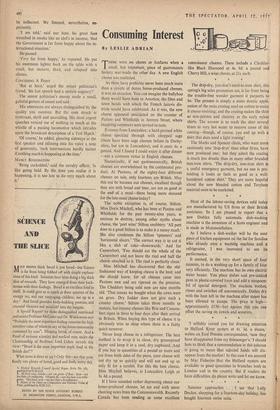Consuming Interest
By LESLIE ADRIAN
HERE were no cheers or fanfares when, a I small, but important, piece of gastronomic history was made the other day. A new English cheese was marketed.
As there. have probably never been much more than a couple of dozen home-produced cheeses, it was an occasion. You can imagine the ballyhoo there would have been in America; the fetes and town bands with which the French laiterie dis- tricts would have celebrated. As it was, the new cheese appeared unticketed on the counter of Paxton and Whitfields in Jermyn Street, where inquiring customers were invited to taste.
It comes from Lancashire; a hard-pressed white cheese speckled through with chopped' sage (there have been sage cheeses before in Derby- shire, but not in Lancashire); and it costs 4s. a pound. And I found I could enjoy it after dinner —not a common virtue in English cheeses.
Numerically, if not gastronomically, British cheeses are overwhelmed by the continental pro- duct. At Paxtons, of the eighty-four different cheeses on sale, only fourteen are British. May this not be because our cheeses, excellent though they are with bread and beer, are not so good at the end' of a meal—there being more demand for the late-meal cheese today?
The noble exception is, of course, Stilton. Miss Doris Mitchell, who has been at Paxton and Whitfields for the past twenty-nine years, is anxious to destroy, among other myths about cheese, the 'port wine' Stilton snobbery. 'All port does to a good Stilton is to make it a messy mush.' She also condemns the Stilton 'spooners' and 'horizontal slicers.' The correct way is to cut it like a slab of cake—downwards.' And for Camembert, 'You should eat the whole of the Camembert and not leave the rind and half the cheese attached to it. The rind is perfectly clean.'
Miss Mitchell has discovered that the old- fashioned way of keeping cheese is the best; and she should know, for all cheeses come into Paxtons new and are ripened on the premises. The Cheddars being sold now are nine months old. 'That means we bought when the cows were on grass. Dry fodder does not give such a creamy cheese.' Stilton takes three months to mature, but creamy cheeses like Brie and Camem- bert ripen in three to four days after their arrival in Britain. When buying this type of cheese it is obviously wise to shop where there is a fairly quick turnover, Never keep cheese in a refrigerator. The best method is to wrap it in clean, dry greaseproof paper and keep it in a cool, dry cupboard. And if you buy in quantities of a pound or more and cut from both sides of the piece, your cheese will not dry up so quickly and will not end up as only fit for a rarebit. For this the best cheese, Miss Mitchell believes, is Lancashire Leigh at 3s. 4d. a pound.
If I have sounded rather depressing about our home-produced cheeses, let me end with some cheering news from the Commonwealth. Recently Canada has been sending us some excellent connoisseur cheeses. These include a Cheddar- like Black Diamond at 4s. 8d. a pound and Cherry Hill, a wine cheese, at 21s. each.
* * The drip-dry, you-don't-need-to-iron shirt, this spring's big sales promotion act, is far from being the trouble-free wonder garment it purports to be. The process is simply a more drastic appli- cation of the resin coating used on cotton to make it crease-resisting; and the coating makes the shirt as non-porous and clammy as the early nylon shirts. The answer is to wash the shirt several times in very hot water to remove some of the coating—though, of course, you end up with a shirt that does need a light ironing!
The Marks and Spencer chain, who went more cautiously into 'drip-drys' than other firms, have now produced one : but they admit the coating is much less drastic than in many other branded non-iron shirts. 'The drip-dry, non-iron shirt is a useful emergency garment, but no one is pre- tending it looks or feels as good as a well- laundered cotton shirt.' They are more hopeful about the new blended cotton and Terylerie material soon to be marketed.
* * *
Most of the labour-saving devices sold today are manufactured by US firms or their British associates. So I am pleased to report that a new Dishlex fully automatic dish-washing machine is the invention of a Scots engineer and is made in Monmouthshire.
As I believe a dish-washer will be the next piece of kitchen equipment on the list for families who already own a washing machine and a refrigerator, I was interested to see its performance.
It seemed, in the very short space of four minutes, to do a washing-up for a family of fOur very efficiently. The machine has its own electric water heater. You place dishes and pre-soaked pans in plastic-covered trays and add a teaspoon- ful of special detergent. The machine washes, rinses and switches off automatically. Dishes dry with the heat left in the machine after steam has been allowed to escape. The price is high— approximately £150—but against this you can offset the saving on towels and scourers.
* *
'I selfishly cursed you for drawing attention to Helford River oysters at 4s. 3d. a dozen,' writes an East Preston correspondent, 'now they have disappeared from my fishmonger's.' I should hate to think that a commendation in this column is going to mean that salected foods will dis- appear from the market! In this case I am assured by Mac Fisheries that the Helford oysters are available in good quantities in branches both in London and in the country. But if readers do have difficulties, do please write and let me know.
* * *
Summer approaches. . . . I see that Lady Docker, shopping for a fourteen-day holiday, has bought fourteen swim suits.


































 Previous page
Previous page